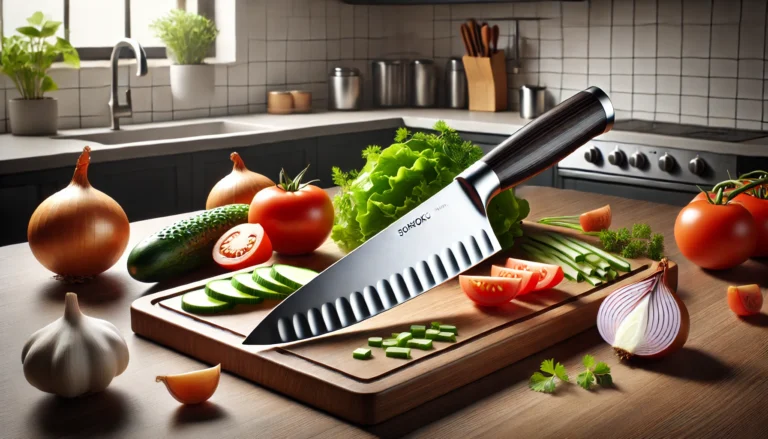
In the vibrant world of culinary arts, the right tools can transform an ordinary cooking experience into an extraordinary one. The usual knife stands out for its precision and versatility among these tools. If you’re a home chef or culinary enthusiast looking to elevate your kitchen game, understanding the uses of an usuba knife is essential. This blog post will guide you through its unique features, benefits, and practical applications so you can make the most of this Japanese culinary marvel.
What is A Usuba Knife Used For? (Short Answer)
A typical knife is primarily used to cut vegetables. Its straight edge makes it ideal for precise slicing, dicing, and chopping. Chefs value it for creating thin, uniform cuts. It’s beneficial for making decorative vegetable carvings. The knife’s thin blade ensures clean cuts without crushing delicate ingredients.
The History and Origin of the Usuba Knife
The usual knife has deep roots in Japanese culinary tradition. Originating from Japan, this knife has been a staple in professional kitchens for centuries. The term “usual” means “thin blade,” indicating its design and primary function. Historically, it was used by professional chefs in Japan to prepare vegetables with precision and artistry. Understanding its origin helps us appreciate its specialized design and role in Japanese cuisine.
Unique Design and Construction
The usual knife is known for its distinctive single-bevel edge, differentiating it from Western-style knives. This design allows for skinny and precise cuts. The blade is straight and flat, perfect for high-accuracy tasks. The knife is usually made from high-carbon steel, ensuring a sharp and durable edge. This construction makes it a reliable tool in any kitchen, especially for those who value precision and quality.
The Art of Using an Usuba Knife
Mastering the usual knife requires practice and skill, but the effort is worth it. The single-bevel edge can be tricky to handle initially, but it allows for cleaner cuts and greater control. To use the knife effectively, it’s essential to hold it correctly and apply even pressure throughout the cut. This technique minimizes the risk of damaging the delicate vegetables you might be working with. Over time, using an usuba knife becomes second nature, enabling you to create beautifully presented dishes.
Perfect Tool for Vegetable Preparation
One primary use of a Usuba knife is preparing vegetables. Its sharp and thin blade is ideal for precisely slicing, dicing, and chopping vegetables. Whether making a salad, stir-fry, or garnish, the Usuba knife ensures uniform cuts, enhancing the presentation and cooking process. Home chefs and culinary enthusiasts will find it particularly useful for tasks that require meticulous attention to detail, such as julienning carrots or finely chopping herbs.
Creating Decorative Garnishes
The usual knife is also a popular choice for creating decorative garnishes. Its precision allows chefs to carve intricate designs into vegetables, adding an artistic touch to their dishes. Techniques such as katsuramuki and peeling vegetables into thin sheets are made possible with the usual knife. This ability to create visually appealing garnishes impresses guests and elevates the overall dining experience.
Versatility in Everyday Cooking
While the usual knife excels in vegetable preparation, its versatility extends to other culinary tasks. It can be used for slicing fruits, mincing herbs, and even filleting fish. This makes it a valuable addition to any kitchen, offering flexibility beyond its primary function. Home cooks will appreciate the knife’s ability to handle a variety of ingredients, making meal preparation more efficient and enjoyable.
Maintaining Your Usuba Knife
Proper maintenance is crucial to keep your usual knife in optimal condition. Regular sharpening is essential to maintain its sharp edge, which is best achieved using a whetstone. Additionally, cleaning the knife thoroughly after each use and drying it immediately to prevent rusting is necessary. Storing the knife properly, preferably in a knife block or on a magnetic strip, helps protect the blade from damage. With proper care, your usuba knife will remain reliable for years.
Usuba Knife vs. Nakiri Knife
While both the usual and nakiri knives are designed for vegetable preparation, they have distinct differences. The Nakiri knife has a double-bevel edge, making it easier for beginners, while the Usuba’s single-bevel edge offers greater precision. Professional chefs typically prefer The usual knife for its ability to create intricate cuts and decorations. Understanding these differences can help home chefs choose the right knife for their needs, depending on their skill level and culinary goals.
Investing in Quality
When purchasing a usuba knife, investing in a high-quality product is essential. Look for knives made from high-carbon steel that offer superior sharpness and durability. Reputable brands and manufacturers often provide better craftsmanship and longevity. While a quality usuba knife may come with a higher price tag, the investment is worthwhile for those who value precision and excellence in their cooking.
Enhancing Your Culinary Experience
Incorporating an usuba knife into your kitchen tools can significantly enhance your culinary experience. The knife’s precision and versatility allow for greater creativity and efficiency in meal preparation. Whether you’re a seasoned chef or a home cook looking to refine your skills, the usual knife offers endless possibilities. Experimenting with different cutting techniques and dishes can be fun and rewarding, leading to beautifully crafted meals that delight the senses.
Joining a Community of Culinary Enthusiasts
Using a knife makes you part of a larger community of culinary enthusiasts who appreciate the art of cooking. Sharing tips, techniques, and recipes with fellow home chefs can inspire new ideas and foster a sense of camaraderie. Online forums, cooking classes, and social media groups are great places to connect with others who share your passion for culinary excellence. Engaging with this community can enhance your knowledge and skills, making your cooking experiences more enjoyable.
Conclusion:
The usual knife is more than a tool; it’s a gateway to culinary artistry and precision. For home chefs and culinary enthusiasts, it offers an opportunity to elevate their cooking and create beautifully presented dishes. By understanding its uses and mastering its techniques, you can unlock a new level of creativity and efficiency in your kitchen. Whether slicing vegetables, creating garnishes, or exploring new recipes, the usuba knife is a valuable companion on your culinary journey.
FAQs
A typical knife is a traditional Japanese kitchen knife with a single-bevel edge. It is primarily designed for precise vegetable cutting and features a flat edge ideal for making thin, uniform slices.
The usual knife differs from other kitchen knives due to its single-bevel edge and thin, flat blade. These features make it perfect for detailed vegetable work, unlike general-purpose knives that might have double-bevel edges and thicker blades.
While the usual knife excels at cutting vegetables, it is not specifically designed for cutting meat. Its single-bevel edge may not provide the best performance for meat and could be more prone to chipping when used on more challenging ingredients.
A typical knife can be used to prepare various vegetable-based dishes. It is excellent for making salads, stir-fries, garnishes, intricate cuts, and decorative carvings like katsuramuki, where vegetables are peeled into thin sheets.
A typical knife may require some practice due to its single-bevel edge, which can be harder to handle than double-bevel knives. However, with some training and experience, beginners can learn to use it effectively and enjoy its precision.






